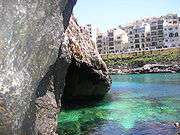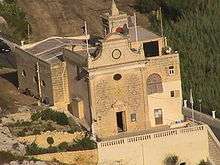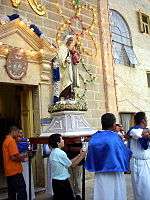Xlendi
| Xlendi | ||
|---|---|---|
| Suburb | ||
| Ix-Xlendi | ||
|
A Panoramic View of Xlendi | ||
| ||
| Motto: Navium Tutela | ||
 Xlendi | ||
| Coordinates: 36°1′47″N 14°13′8″E / 36.02972°N 14.21889°ECoordinates: 36°1′47″N 14°13′8″E / 36.02972°N 14.21889°E | ||
| Country |
| |
| Island |
| |
| Suburb of |
| |
| Demonym(s) | Xlendin | |
| Time zone | CET (UTC+1) | |
| • Summer (DST) | CEST (UTC+2) | |
| Postal code | MXR | |
| Dialing code | 356 | |
| Patron saint | Our Lady of Mount Carmel | |
| Website | Munxar Local Council | |
Xlendi is a village in Malta situated in the south west of the island of Gozo. It is surrounded by the villages of Munxar, Fontana and Kerċem. The village is administered by Munxar,[1] but has its own coat of arms and motto. From March 2010, Xlendi has had its own 5-person "mini council" responsible for the main activities of the area.
Etymology
The name Xlendi is of Byzantine origins as it is named after a galley of the period, that was wrecked along the coast, that was called Shilandi. Evidence of this was retrieved near the entry of the bay, at the bottom of the sea, in the 1960s. Since then the site became a popular diving site.[2]
Historical places
Punic Tombs
Also Tombs dating Punic-Byzantine times were found in Xlendi, some at St. Simon Point (under St Simon Street) and some others in Xlendi Valley.[3] Romans used to port in Xlendi as it has features that can protect from the wind for its cliffs around the bay. In the middle of the bay there is a reef that many ships shipwrecked against it. These ships left a large number of Roman amphora on the sea bed in the mouth of the bay.
Xlendi Tower
The Xlendi Tower guarding the mouth of the bay was built by the Grandmaster Juan de Lascaris-Castellar on 29 June 1650. This was built so pirates or Turks could not disembark from this bay. This tower is still standing. It has, until recently been abandoned with substantial damage caused to the outer walls of the tower. Responsibility for the tower was passed to the Local Council and Din l-Art Ħelwa in 2010. It is anticipated that restoration work will be commenced during 2011. The Tower was quite important for the British Army in Malta as it was the only tower in the southwest of the island. It was entitled Tower B (secondly in place) to show its importance.
Chapels
It is strange that in Xlendi in the middle 17th century had a total of 4 chapels. These were: St Simon Chapel (St Simon Point) which also had a cemetery and when profaned, the bishop ordered that a stone cross should be carved in the rocks; St Domenica which was an underground chapel located roughly on the cliffs over the valley of Xlendi on the side of Munxar and was difficult to reach it so it was profaned soon after it was established; St Catherine was established over Xlendi on the cliffs on the side of the village of Kercem. It was built over a cliff which bears the same name. It is said that there was a small community in the areas of this chapel; 'Vizitazzjoni ta' Forn il-Gir' was not much visited by people. It was established between Munxar and Xlendi but very little is known about it. All of these chapels were profaned between the 1650s and the 1680s.
The church, dedicated to Our Lady of Mount Carmel, was dedicated in 1974, but some parts of the building are far older, dating to 1868. Every year, on the first Sunday of September, a feast dedicated to the patron saint, is held. In the Afternoon, water games are held at the bay with the traditional 'gostra' a greasy pole which the players have the walk on to catch a flag. In the evening a procession with the statue of Our Lady of Mount Carmel is held around Xlendi.[4]
Underground Emergency Mill
In 1955, the Xlendi mill was excavated into the cliffs, situated behind the Mount Carmel church. The excavation was a huge undertaking, which consisted firstly of an entrance tunnel, some 30 meters long, 2.5 meters high and 3 meters wide, leading into a large chamber. This chamber was divided into three floors and housed the storage, grinding and milling equipment. At the rear of the mill is the silo, having a storage capacity of approximately 1,000 tons of wheat, and connected to the milling machinery by mechanical augers. An 80 hp diesel engine and alternator supplied power. Entrances from above can also access the silo. The Mill was built when the Cold War was escalating when nuclear conflict was possible. This Mill was nuclear safe. But this mill was never used after built.
Topography

This village has a great topography with quite steep cliffs on the side and a valley on the back which takes rain water from the villages surrounding it (Kerċem, Munxar, Fontana and Victoria) into the bay.
Xlendi Bay
In the British rule, Xlendi was a bay holding a sandy bay but by time wave, the valley water and human interference now Xlendi holds a few pebbles. The bay is still known for the rocks on the left side of the bay which are good for sunbathing and for diving.
Valleys
Xlendi Valley starts from Fontana continuing from the Lunzjata Valley and Wied l-Ghawdxija and ends in the bay into the sea. So Xlendi Valley collects almost all the rain that falls on the adjacent villages of Kerċem, Munxar and Fontana. The rain water goes through Xlendi and this is quite a problem for most citizens living in Xlendi because they are isolated by the fast flowing water. This also causes flooding in the buildings on the main road from where the valley water passes. This valley is one of the very few homes to the Maltese Freshwater Crab.
Il-Kantra is a valley on the left of the bay just beside the Tower. The name Kantra derives from Alcantara in Spanish-Sicilian. This is because of the entrance of the valley and the valleys' form. From the entrance of this valley, it could be seen as a bow. This valley is home to many types of flora and fauna because not many people go in the valley. The Tower of Xlendi was reached by a bridge built by the Knights of Saint John over the Kantra Valley.
Caves

There are many caves, small or large, on the sides of the bay. The main and most known caves are:
Caroline Cave is a cave on the right cliffs of the bay. It was once property of Caroline Cauchi, a rich woman from Victoria. Later she founded the Augustinian Sisters on Gozo and donated almost all of her land, including the cave and other land in Xlendi. The Sisters during summers started to stay at Xlendi. They would go for a swim in this cave which was isolated and could only be reached by stairs. So they would use this cave as their own and would not be seen by other people in the bay.
Catherine of Siena Cave is situated outside the bay on the right side. It is well known for the very clear blue water. In the 17th century, people used to live in the areas around the cave and built a church just over the cave. So the cave got its name from the saint to which the church was dedicated.
Nature
The not developed area around Xlendi is home from a lot of flora and fauna species some of them rare. One can name the Seagulls, the Maltese Freshwater Crab and the 'Widnet il-Bahar'. Today, Xlendi is one of the most developed areas on the island, a feature that damages the biodiversity in the area. The 3 km stretch of cliffed coastline from Xlendi Bay westwards to Wardija Point forms the Xlendi Bay to Wardija Point Cliffs Important Bird Area, identified as such by BirdLife International because of its importance for two species of breeding shearwaters.[5]
Notable people
- Caroline Cauchi
Carolina Cauchi was born in Senglea on 25 December 1824, the only child of the Notary Nicolò Cauchi, from Victoria, Gozo and Theresa née Galea from Senglea, Malta. The family Cauchi was affluent, therefore Carolina was sent off to school to continue her education, in spite of the fact that at the time girls received little education. Carolina learned to write Italian well and she knew Latin as well. Above all she received an optimal Christian upbringing.
The first Dominican community consisting of 9 women was born on 6 October 1889, feast of Our lady of the Rosary. These women after taking part in the procession returned to the monastery and started to live as contemplative nuns. However, until this community was formally recognized and accepted by the Dominican Order in August 1893 the ideal was modified and they started to be known as a community of the Dominican Third Order.

Caroline knew how to use the material goods she possessed for the glory of God and the good of humanity. She lived the spirit of poverty after the example of Our Mother Mary and Saint Dominic. At the beginning she frequently visited the Sisters but she never stayed at the monastery. During the summer she would often invite the Sisters for a vacation at her holiday house in Xlendi. She was pleased to see the Congregation growing in number and progressing in the apostolate. In fact, she confirmed her former dispositions in favour of the Monastery.[6]
The Father of Carolina, Notary Nicolo, was given some land, from the Our Lady of Mount Carmel Monks of Mdina, so that a chapel dedicated to Our Lady of Mount Carmel to be built.
- Constance Strickland
Constance Strickland made great restoration of the Xlendi Tower in two years starting in the year 1956, because the Tower was almost falling. But soon after the restoration in 1979 the tower fell again in bad condition.
- Tony Portelli - Ta' Talija
Tony Portelli was famous for his life in Xlendi. He had a small shop where he sold some soft drinks, biscuits and food to people in Xlendi. Tony was also famous for his rabbit stew and many Maltese used to go to eat at his house. He also had some goats and used to go at his fields on the right cliffs of Gozo.
- Gianni ta' Berta
Gianni was the local police for most of his life. He used to stay on guard in large storms because of the strong water currents coming from the valley. Gianni was well known for his seriousness about his work. He used to help the Rector who lived out of the village and used to open the chapel early in the morning and ring the bells.
- Ta' Gori Family
This family owned a large area of fields in which they worked all day. They had some other people helping them because they had a lot of work to do. They also had about 6 cows which was a rarity in these islands in those periods. Their crops and milk were sold to the citizens and the extra was sold at Kercem.

- Rectors
- Rafel Cassar 1872-1904
- Ganni Marija Attard 1905-1931
- Indri Buhagiar 1931-1939
- Karm Grech 1939-1941
- Guzeppi Grech 1941-1944
- Anton Grech Sciluna 1944-1960
- Guzeppi Curmi 1960-1984
- John Bosco Cremona 1984-(present)
Xlendi roads
- Pjazza l-Anfori (Anfori Square)
- Triq il-Qsajjam
- Triq ir-Rabat (Victoria Road)
- Triq Ras il-Bajjada (Ras il-Bajjada Road)
- Triq San Xmun (St Simon Road)
- Triq il-Bizantini (Byzantine Street)
- Triq ir-Rumani (Romans Street)
- Triq il-Punici (Punic Street)
- Triq it-Torri (Tower Street)
- Triq il-Kantra (Kantra Street)
- Triq il-Kavallieri (Knights Street)
- Triq iz-Zirzieb (Slippery Street)
- Triq l-Ghar ta' Karolina (Caroline Cave Street)
- Triq Sienja (Sienja Street)
- Triq ir-Rancis (Rancis (a flower) Street)
- Triq Qroll (Coral Street)
- Triq tal-Karmnu (Our Lady of Mount Carmel Street)
- Triq ix-Xlendi (Xlendi Street)
- Triq is-Sajjieda (Fishers' Street)
- Triq Sant' Indrija (Saint Andrew Street)
References
- ↑ http://www.munxar.gov.mt
- ↑ http://www.gozoviews.com/gozo-history/the-citadel?start=1
- ↑ http://www.megalithic.co.uk/article.php?sid=10449
- ↑ "Archived copy". Archived from the original on 30 April 2010. Retrieved 5 September 2009.
- ↑ "Xlendi Bay to Wardija Point Cliffs". Important Bird Areas factsheet. BirdLife International. 2013. Archived from the original on 10 July 2007. Retrieved 2013-08-04.
- ↑ "Archived copy". Archived from the original on 26 November 2010. Retrieved 4 September 2009.

.png)